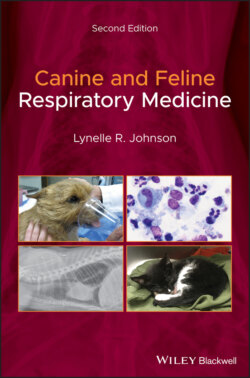Читать книгу Canine and Feline Respiratory Medicine - Lynelle Johnson R., Lynelle R. Johnson - Страница 29
Physical Examination
ОглавлениеBody temperature can be somewhat helpful in distinguishing cardiac from respiratory disease at least in cats, as low body temperatures are more typical with cardiac disease (Dickson et al. 2018), although substantial overlap can be found. Heart rate is helpful in differentiating cardiac from respiratory disease in the dog, because dogs with respiratory disease often have elevated vagal tone, which leads to a slower heart rate and an exaggerated respiratory arrhythmia. In congestive heart failure, activation of the sympathetic nervous system leads to an increased heart rate, and the presence of a tachyarrhythmia would make cardiac disease more likely in a dog. One exception to this rule might be the Miniature Schnauzer, which can have a low heart rate in heart failure because of concurrent sinus node disease. Heart rate is less helpful in differentiating cardiac from respiratory disease in cats, because they rarely develop a sinus arrhythmia and are more likely to be tachycardic due to stress, but there is a general trend toward higher heart rates in cats with cardiac causes of respiratory distress (Dickson et al. 2018).
Murmurs in dogs and cats are not highly sensitive or specific for confirming congestive failure as a cause for clinical signs, although murmur intensity as well as progressive increase in intensity appears to be an important indicator of clinically significant cardiac disease in dogs with myxomatous mitral valve disease (Lord et al. 2010, 2011).
Dogs with pulmonary hypertension as a consequence of primary lung disease can also display a prominent heart murmur. Heart murmurs in cats are neither sensitive nor specific for heart disease, because a substantial proportion of cats with hypertrophic cardiomyopathy lack a heart murmur and the physiologic murmur of right ventricular outflow tract obstruction is very common in cats.
Detection of a gallop sound is highly suggestive of substantial cardiac disease, particularly hypertrophic cardiomyopathy in the cat and dilated cardiomyopathy in the dog. Arrhythmias, and especially tachyarrhythmias, with pulse deficits would be much more commonly encountered in an animal with heart disease than in an animal with a respiratory cause of signs.
Tachypnea or hyperpnea can be found in animals with disease of cardiac or respiratory origin. Pneumonia, pulmonary edema, and interstitial fibrosis result in restrictive lung disease due to stiffening of the pulmonary parenchyma that leads to rapid, shallow breathing. Pleural effusion of cardiac, respiratory, or systemic origin will also result in an elevated respiratory rate. In some dogs and cats with chronic bronchitis and in dogs with tracheobronchomalacia, increased expiratory effort, prolonged expiratory time, and abdominal effort on expiration can be seen. Wheezes might be ausculted on expiration in these animals or inspiratory and expiratory crackles heard in dogs. The crackles detected in animals with bronchial disease are generally harsher and moister than those heard in dogs or cats with pulmonary edema. In many animals with heart failure, lung sounds are relatively normal or only very fine, soft crackles can be ausculted. Crackles on inspiration can be prominent in dogs with pulmonary fibrosis, and these adventitious lung sounds can be ausculted over the entire thorax in animals with pulmonary fibrosis. Crackles in animals with pneumonia are sometimes localized to certain lung regions. In an animal with aspiration pneumonia, abnormal lung sounds may be localized to the cranioventral lung regions or the middle lung lobes.
If pleural effusion is present due to pulmonary, cardiac, or systemic causes, heart and lung sounds will be dampened ventrally, while lung sounds are heard in the dorsal lung regions. Pleural effusion due to right heart disease is generally associated with distention of the jugular veins due to increased venous pressure. A hepatojugular reflux, enlarged liver, or ascites may also be detected. In cats, pleural and pericardial effusion can occur due to left‐sided heart disease. Pleural effusion associated with infectious etiologies (pyothorax in the dog and cat or feline infectious peritonitis in the cat) is more likely to result in fever than non‐infectious causes.
